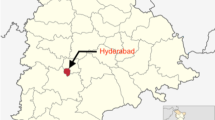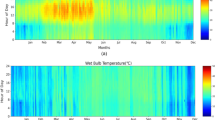Abstract
To track the driving forces of rebound effects, the household electricity consumption of air conditioner (AC) was decomposed into the number, power size, and operating hours of AC. A set of regression models was built to find the influence pathways of increasing electricity consumption. Then, a two-stage decision-making process of AC purchase was studied to find the target customers of energy-efficient AC, using the joint estimation of logistic and zero-truncated negative binomial regression models. Data of 371 households in Hsinchu County in Taiwan were used based on the questionnaire survey of the household energy consumption behavior in 2018. Estimated results indicated that households having energy-efficient AC tend to install larger-power size ones causing the electricity consumption of AC to increase. Oversized AC was the main driving force of rebound effects. Contrarily, the using time of AC was not the key influence factor on electricity consumption. Estimated results also indicated that households living in urban apartments, especially for those with large floor area, would have higher probability of choosing energy-efficient AC and would install a greater number of that.





Similar content being viewed by others
Notes
Hsinchu County is in north-western Taiwan. After the founding of Hsinchu Science Park in 1980, a large number of high-tech industries began to grow and expand in Hsinchu County which attracted workers coming to work and settle in the county. Compared to other cities or counties, Hsinchu County is a new developing region combining the traditional Hakka cultural and young households of high-tech workers. The multicultural contributes the diversity of the sample survey.
The second electricity-consuming appliance was lighting, using 20% of residential electricity consumption, and following were TV (9%) and refrigerator (7%). The electricity consumption of other appliances was less than 5% according to Su (2019).
The power size was originally asked with the unit of refrigeration ton (RT) in the questionnaire survey. RT is a unit of power used in Taiwan to describe the heat extraction capacity of air conditioning equipment.
Count data is a type of data in which the observations can take only the non-negative integer values {0, 1, 2, 3, …}. When count data are treated as a random variable, the Poisson, binomial, and negative binomial distributions are commonly used to represent its distribution.
References
Alberini, A., & Filippini, M. (2011). Response of residential electricity demand to price: The effect of measurement error. Energy Economics, 33(5), 889–895.
Bentzen, J. (2004). Estimating the rebound effect in US manufacturing energy consumption. Energy Economics, 26(1), 123–134.
Berkhout, P. H., Muskens, J. C., & Velthuijsen, J. W. (2000). Defining the rebound effect. Energy Policy, 28(6–7), 425–432.
Boogen, N., Datta, S., & Filippini, M. (2017). Dynamic models of residential electricity demand: Evidence from Switzerland. Energy Strategy Reviews, 18, 85–92.
Brookes, L. (1990). The greenhouse effect: The fallacies in the energy efficiency solution. Energy Policy, 18(2), 199–201.
Cayla, J. M., Maizi, N., & Marchand, C. (2011). The role of income in energy consumption behaviour: Evidence from French households data. Energy Policy, 39(12), 7874–7883.
Coleman, M., Brown, N., Wright, A., & Firth, S. K. (2012). Information, communication and entertainment appliance use—Insights from a UK household study. Energy and Buildings, 54, 61–72.
Cui, W., Ding, Y., Hui, H., Lin, Z., Du, P., Song, Y., & Shao, C. (2018). Evaluation and sequential dispatch of operating reserve provided by air conditioners considering lead–lag rebound effect. IEEE Transactions on Power Systems, 33(6), 6935–6950.
Cui, G., Liu, B., Luan, W., & Yu, Y. (2019). Estimation of target appliance electricity consumption using background filtering. IEEE Transactions on Smart Grid, 10(6), 5920–5929.
Dasgupta, S., & Roy, J. (2015). Understanding technological progress and input price as drivers of energy demand in manufacturing industries in India. Energy Policy, 83, 1–13.
Davis, L. W. (2008). Durable goods and residential demand for energy and water: Evidence from a field trial. The RAND Journal of Economics, 39(2), 530–546.
Druckman, A., Chitnis, M., Sorrell, S., & Jackson, T. (2011). Missing carbon reductions? Exploring rebound and backfire effects in UK households. Energy Policy, 39(6), 3572–3581.
Ek, K., & Söderholm, P. (2010). The devil is in the details: Household electricity saving behavior and the role of information. Energy Policy, 38(3), 1578–1587.
Espey, J. A., & Espey, M. (2004). Turning on the lights: A meta-analysis of residential electricity demand elasticities. Journal of Agricultural and Applied Economics, 36(1), 65–81.
Filippini, M., Hirl, B., & Masiero, G. (2018). Habits and rational behaviour in residential electricity demand. Resource and Energy Economics, 52, 137–152.
Filippini, M., & Pachauri, S. (2004). Elasticities of electricity demand in urban Indian households. Energy Policy, 32(3), 429–436.
Frondel, M., Peters, J., & Vance, C. (2008). Identifying the rebound: Evidence from a German household panel. The Energy Journal, 29(4).
Frondel, M., Ritter, N., & Vance, C. (2012). Heterogeneity in the rebound effect: Further evidence for Germany. Energy Economics, 34(2), 461–467.
Gorter, J. L. (2012). HVAC equipment right-sizing: Occupant comfort and energy savings potential. Energy Engineering, 109(1), 59–75.
Greening, L. A., Greene, D. L., & Difiglio, C. (2000). Energy efficiency and consumption—The rebound effect—A survey. Energy Policy, 28(6–7), 389–401.
Grepperud, S., & Rasmussen, I. (2004). A general equilibrium assessment of rebound effects. Energy Economics, 26(2), 261–282.
Guo, Z., Zhou, K., Zhang, C., Lu, X., Chen, W., & Yang, S. (2018). Residential electricity consumption behavior: Influencing factors, related theories and intervention strategies. Renewable and Sustainable Energy Reviews, 81, 399–412.
Gram-Hanssen, K., Kofod, C., & Petersen, K. N. (2004). Different everyday lives: Different patterns of electricity use. In Proceedings of the 2004 American Council for an Energy Efficient Economy, 1–13.
Ha, H. Y., & Janda, S. (2012). Predicting consumer intentions to purchase energy-efficient products. Journal of Consumer Marketing, 29(7), 461–469.
Hart, G. W. (1992). Nonintrusive appliance load monitoring. Proceedings of the IEEE, 80(12), 1870–1891.
Haas, R., & Biermayr, P. (2000). The rebound effect for space heating: Empirical evidence from Austria. Energy Policy, 28(6–7), 403–410.
Houthakker, H. S. (1951). Some calculations on electricity consumption in Great Britain. Journal of the Royal Statistical Society Series A (General), 114(3), 359–371.
Hu, S., Yan, D., Guo, S., Cui, Y., & Dong, B. (2017). A survey on energy consumption and energy usage behavior of households and residential building in urban China. Energy and Buildings, 148, 366–378.
Hung, M. F., & Huang, T. H. (2015). Dynamic demand for residential electricity in Taiwan under seasonality and increasing-block pricing. Energy Economics, 48, 168–177.
IEA (2019), Energy efficiency is the first fuel, and demand for it needs to grow. IEA, Paris https://www.iea.org/commentaries/energy-efficiency-is-the-first-fuel-and-demand-for-it-needs-to-grow.
Jevons, W. S. (1866). The coal question: An inquiry concerning the progress of the nation, and the probable exhaustion of our coal mines (2 ed.). London, Macmillan & Co.
Jin, S. H. (2007). The effectiveness of energy efficiency improvement in a developing country: Rebound effect of residential electricity use in South Korea. Energy Policy, 35(11), 5622–5629.
Jones, R. V., & Lomas, K. J. (2016). Determinants of high electrical energy demand in UK homes: Appliance ownership and use. Energy and Buildings, 117, 71–82.
Khazzoom, J. D. (1980). Economic implications of mandated efficiency in standards for household appliances. The Energy Journal, 1(4).
Lijesen, M. G. (2007). The real-time price elasticity of electricity. Energy Economics, 29(2), 249–258.
Long, J. S., & Freese, J. (2006). Regression models for categorical dependent variables using Stata (Vol. 7). Stata Press.
Mata, É., Ottosson, J., & Nilsson, J. (2020). A review of flexibility of residential electricity demand as climate solution in four EU countries. Environmental Research Letters, 15(7), 073001.
Mills, B., & Schleich, J. (2010). What’s driving energy efficient appliance label awareness and purchase propensity? Energy Policy, 38(2), 814–825.
Nesbakken, R. (2001). Energy consumption for space heating: A discrete–continuous approach. Scandinavian Journal of Economics, 103(1), 165–184.
Parker, D. S. (2003). Research highlights from a large scale residential monitoring study in a hot climate. Energy and Buildings, 35(9), 863–876.
Rhodes, J. D., Stephens, B., & Webber, M. E. (2011). Using energy audits to investigate the impacts of common air-conditioning design and installation issues on peak power demand and energy consumption in Austin. Texas. Energy and Buildings, 43(11), 3271–3278.
Roy, J. (2000). The rebound effect: Some empirical evidence from India. Energy Policy, 28(6–7), 433–438.
Santamouris, M., Cartalis, C., Synnefa, A., & Kolokotsa, D. (2015). On the impact of urban heat island and global warming on the power demand and electricity consumption of buildings—A review. Energy and Buildings, 98, 119–124.
Sapci, O., & Considine, T. (2014). The link between environmental attitudes and energy consumption behavior. Journal of Behavioral and Experimental Economics, 52, 29–34.
Saunders, H. D. (2000). A view from the macro side: Rebound, backfire, and Khazzoom-Brookes. Energy Policy, 28(6–7), 439–449.
Schleich, J., Mills, B., & Dütschke, E. (2014). A brighter future? Quantifying the rebound effect in energy efficient lighting. Energy Policy, 72, 35–42.
Stapleton, L., Sorrell, S., & Schwanen, T. (2016). Estimating direct rebound effects for personal automotive travel in Great Britain. Energy Economics, 54, 313–325.
Sorrell, S., Dimitropoulos, J., & Sommerville, M. (2009). Empirical estimates of the direct rebound effect: A review. Energy Policy, 37(4), 1356–1371.
Su, Y. W. (2019). Residential electricity demand in Taiwan: Consumption behavior and rebound effect. Energy Policy, 124, 36–45.
Su, Y. W. (2020). Residential electricity demand in Taiwan: The effects of urbanization and energy poverty. Journal of the Asia Pacific Economy, 25(4), 733–756.
Torriti, J. (2014). A review of time use models of residential electricity demand. Renewable and Sustainable Energy Reviews, 37, 265–272.
Wang, H., Zhou, P., & Zhou, D. Q. (2012). An empirical study of direct rebound effect for passenger transport in urban China. Energy Economics, 34(2), 452–460.
Wang, Z., & Lu, M. (2014). An empirical study of direct rebound effect for road freight transport in China. Applied Energy, 133, 274–281.
White, H. (1996). Estimation, inference and specification analysis (No. 22). Cambridge university press.
Wyatt, P. (2013). A dwelling-level investigation into the physical and socio-economic drivers of domestic energy consumption in England. Energy Policy, 60, 540–549.
Yamamoto, Y., Suzuki, A., Fuwa, Y., & Sato, T. (2008). Decision-making in electrical appliance use in the home. Energy Policy, 36(5), 1679–1686.
Yoo, S. H., Lee, J. S., & Kwak, S. J. (2007). Estimation of residential electricity demand function in Seoul by correction for sample selection bias. Energy Policy, 35(11), 5702–5707.
Zeifman, M., & Roth, K. (2011). Nonintrusive appliance load monitoring: Review and outlook. IEEE Transactions on Consumer Electronics, 57(1), 76–84.
Zhang, Y. J., Peng, H. R., & Su, B. (2017). Energy rebound effect in China’s industry: An aggregate and disaggregate analysis. Energy Economics, 61, 199–208.
Zhang, Y. J., & Peng, H. R. (2017). Exploring the direct rebound effect of residential electricity consumption: An empirical study in China. Applied Energy, 196, 132–141.
Zhang, Y. J., Peng, H. R., Liu, Z., & Tan, W. (2015). Direct energy rebound effect for road passenger transport in China: A dynamic panel quantile regression approach. Energy Policy, 87, 303–313.
Zou, B., & Mishra, A. K. (2020). Appliance usage and choice of energy-efficient appliances: Evidence from rural Chinese households. Energy Policy, 146, 111800.
Acknowledgements
I thank Dr. Bertoldi and the four anonymous reviewers for their comments. I also thank Mr. Jhong-Han Li for the practical suggestions of this research, and Ms. Monica Peng and Ms. Lilliam Lin of the Stoics Market Research Consultancy for the survey assistance.
Funding
The work was supported by the Bureau of Energy in Taiwan with the grant number 110-E0401 and the Newsys Environmental Technology, Inc., with the grant number 201858N0044A-01.
Author information
Authors and Affiliations
Contributions
The author confirms sole responsibility for the following: study conception and design, data collection, analysis and interpretation of results, and manuscript preparation.
Corresponding author
Ethics declarations
Conflict of interest
The author declares no competing interests.
Additional information
Publisher's note
Springer Nature remains neutral with regard to jurisdictional claims in published maps and institutional affiliations.
Rights and permissions
About this article
Cite this article
Su, YW. The rebound effects of energy-efficient air conditioners: buy more, bigger, or use longer?. Energy Efficiency 15, 29 (2022). https://doi.org/10.1007/s12053-022-10034-z
Received:
Accepted:
Published:
DOI: https://doi.org/10.1007/s12053-022-10034-z




